1977 124 Spider CS1 - Lincolnshire UK
-
PumaPhil
- Posts: 71
- Joined: April 22nd, 2013, 5:18 pm
- Location: Lincolnshire, UK
- Contact:
Re: 1977 124 Spider CS1 - Lincolnshire UK
Some pictures of the engine after its first run in the car.
The manifold went a beautiful gold colour after its first quick run.
The manifold went a beautiful gold colour after its first quick run.
GC-05
'If you think experts are expensive, you should try amateurs!'
A redline run my GC's engine: https://www.youtube.com/watch?v=80nEhsJbH2w
'If you think experts are expensive, you should try amateurs!'
A redline run my GC's engine: https://www.youtube.com/watch?v=80nEhsJbH2w
-
PumaPhil
- Posts: 71
- Joined: April 22nd, 2013, 5:18 pm
- Location: Lincolnshire, UK
- Contact:
Re: 1977 124 Spider CS1 - Lincolnshire UK
So I thought I's post some of the last pictures before it got on the road.
How lovely does that exhaust look!
This looks so much nicer than before.
How lovely does that exhaust look!
This looks so much nicer than before.
GC-05
'If you think experts are expensive, you should try amateurs!'
A redline run my GC's engine: https://www.youtube.com/watch?v=80nEhsJbH2w
'If you think experts are expensive, you should try amateurs!'
A redline run my GC's engine: https://www.youtube.com/watch?v=80nEhsJbH2w
-
PumaPhil
- Posts: 71
- Joined: April 22nd, 2013, 5:18 pm
- Location: Lincolnshire, UK
- Contact:
Re: 1977 124 Spider CS1 - Lincolnshire UK
Well I finally got my Spider on the road for a test run after it failed its MoT due to the brake pedal having too much travel and the handbrake being as much use as a crutch with a wheel on it. This long pedal travel was due to me upgrading to modern Fiat 500 1.4 Abarth vented discs and X-19 rear calipers (adaptor plate from Allison's Automotive). Consequently the standard servo and master cylinder weren't up to the job of shifting the additional volume of brake fluid. So I ended up buying a 'Brake Booster HP' from Spider Point and it has utterly transformed the brakes due to its 22 mm master cylinder (19 mm standard) and beefier servo. The brakes now have a have great progressive feel and real bite, plus the handbrake actually works now! I think the extra pressure whilst adjusting the slack in the handbrake has made all the difference.
So what about the engine? Well, I had an enormous grin on my face after my drive as Guy's engine is simply awesome. It is very civilised and drivable on the first progressive choke (32 mm) and when I put my foot down the difference is pretty startling as the second choke (36 mm) flips open - Wow! It behaves exactly as I briefed Guy that I wanted it; a nice broad spread of torque as I only want this as a ROAD car and not for track use - but with a fair bit more power (obviously!) but not race power. There is of course a big rush of power as the tacho sprints towards the red line, but there is plenty of smooth power available from lower revs - perfect. It is basically fantastic! And the lightening of the flywheel and the incredible pistons designed by Guy make it hungry for revs.
But what about the exhaust? Well it makes a lovely noise. I didn't want a booming drone at motorway speeds or something that would sound like some chav in a Vauxhall Nova, but thankfully Lance knows his stuff and the twin straight-through silencers certainly do the Sport/GT style of the Spider justice. It sounds just right, sporty but not annoying when driving through residential areas at night but certainly sporty when I give it the beans!
So I am a very happy man who has a fantastic engine matched with modern powerful progressive brakes.
I will post a link of a video on YouTube of how it drives and sounds - if I can figure out how to do it.
The next job will be to take it to a rolling road to fine tune to carb as there is a slight flat spot at low revs and this is the only way to effectively sort that. I will also get a full-power run done as I'm hoping for at least around 130-140 bhp - I'll post the results when I get them.
So what about the engine? Well, I had an enormous grin on my face after my drive as Guy's engine is simply awesome. It is very civilised and drivable on the first progressive choke (32 mm) and when I put my foot down the difference is pretty startling as the second choke (36 mm) flips open - Wow! It behaves exactly as I briefed Guy that I wanted it; a nice broad spread of torque as I only want this as a ROAD car and not for track use - but with a fair bit more power (obviously!) but not race power. There is of course a big rush of power as the tacho sprints towards the red line, but there is plenty of smooth power available from lower revs - perfect. It is basically fantastic! And the lightening of the flywheel and the incredible pistons designed by Guy make it hungry for revs.
But what about the exhaust? Well it makes a lovely noise. I didn't want a booming drone at motorway speeds or something that would sound like some chav in a Vauxhall Nova, but thankfully Lance knows his stuff and the twin straight-through silencers certainly do the Sport/GT style of the Spider justice. It sounds just right, sporty but not annoying when driving through residential areas at night but certainly sporty when I give it the beans!
So I am a very happy man who has a fantastic engine matched with modern powerful progressive brakes.
I will post a link of a video on YouTube of how it drives and sounds - if I can figure out how to do it.
The next job will be to take it to a rolling road to fine tune to carb as there is a slight flat spot at low revs and this is the only way to effectively sort that. I will also get a full-power run done as I'm hoping for at least around 130-140 bhp - I'll post the results when I get them.
GC-05
'If you think experts are expensive, you should try amateurs!'
A redline run my GC's engine: https://www.youtube.com/watch?v=80nEhsJbH2w
'If you think experts are expensive, you should try amateurs!'
A redline run my GC's engine: https://www.youtube.com/watch?v=80nEhsJbH2w
-
PumaPhil
- Posts: 71
- Joined: April 22nd, 2013, 5:18 pm
- Location: Lincolnshire, UK
- Contact:
Re: 1977 124 Spider CS1 - Lincolnshire UK
So I took my spider to a rolling road that is run by a guy who has lots of experience with Formula Fords because he knows the Weber 32/36 DGVs inside out. He changed a few jets and made the engine much smoother but I am still awaiting an emulsion tube which he didn't have in stock so there is still a slight hesitation at low revs. The great news is that the rolling road proved that Guy produced an engine which has exactly the sort of power I was after, 148 bhp at the flywheel and is very drivable and torquey. I will need to go to a different rolling road that has a digital readout to see the torque and power curves as the one I went to has good old fashioned gauges.
Unfortunately the tune-up did not cure the pinking at high revs under load. So Guy and I assumed this had to be caused by the high under bonnet temperatures. I am sure these are higher than normal because of the much longer primary pipes from the exhaust manifold, coupled with the small K&N filter sitting in the warmest part of the engine bay.
So as you can see I fitted a plenum adaptor from Webcon and a K&N Apollo ambient air intake system that has cured the pinking and is very neat to boot!
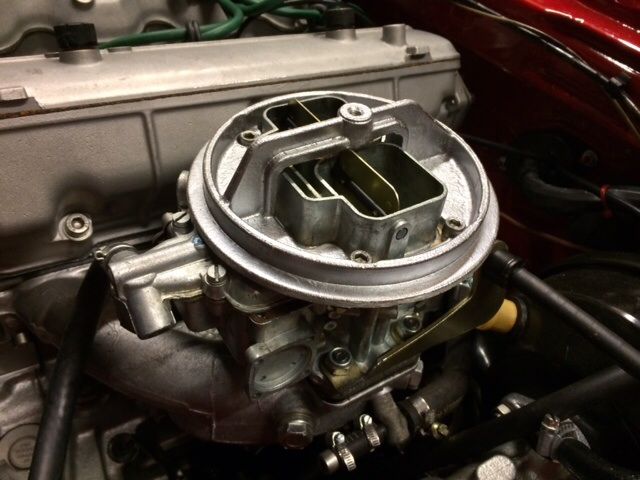
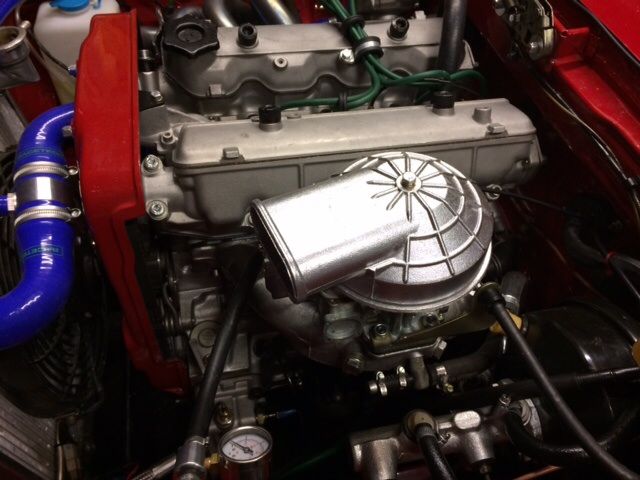
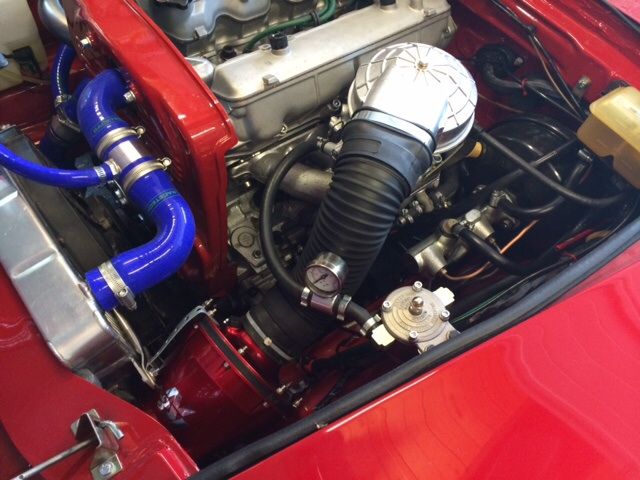
I have been having problems with the uprated distributor as the metal trigger ring on the rotor kept slipping, probably due to differential heating, so I fitted a Computronix system from Allison's with a dual coil pack. It is a very powerful system and is a neat installation as you can see:
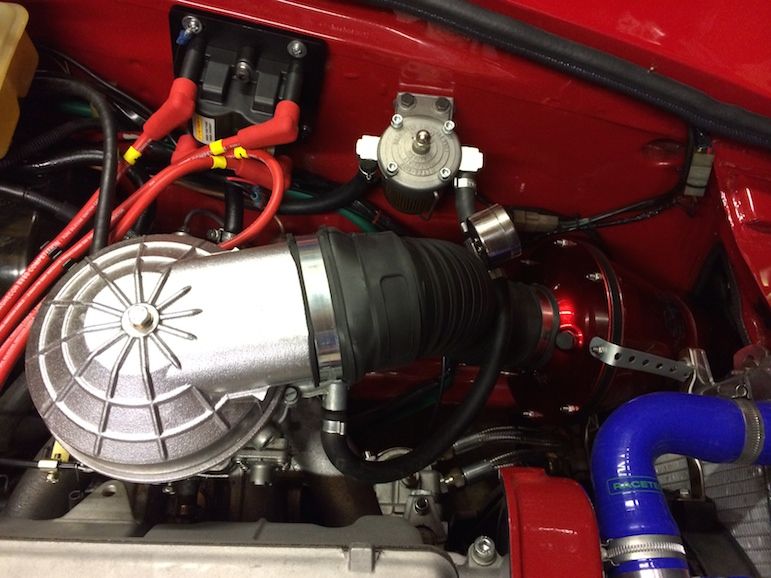
Here you can see the distinctive trigger unit/distributor:
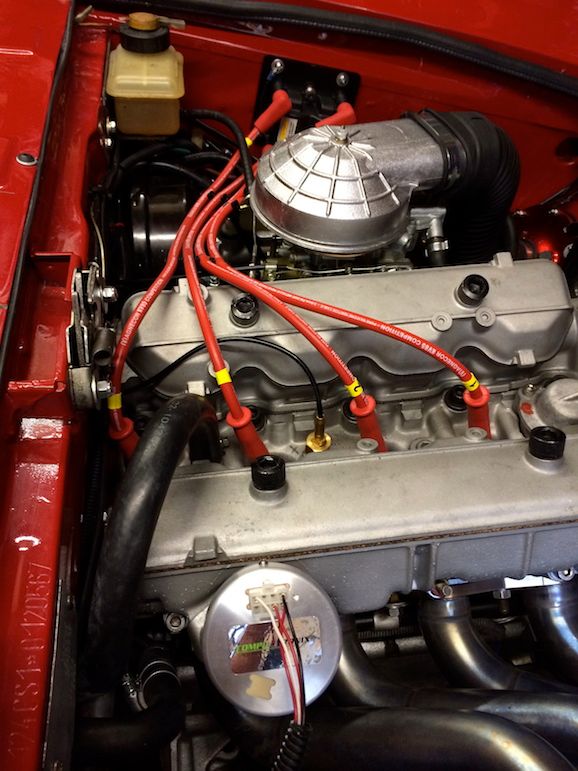
After the engine was installed I kept getting heating issues as the radiator sits lower than the engine so it was difficult to get rid of air pockets so I fitted a new header tank and you can also see the crank case breather tank on the left.
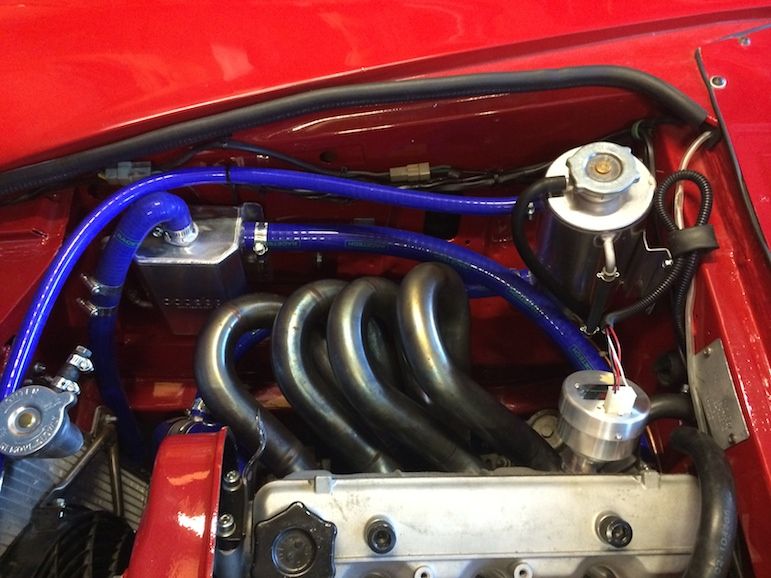
This left no space for the screen wash bottle so the only place I could find was under the carb area! I'll see how that goes!
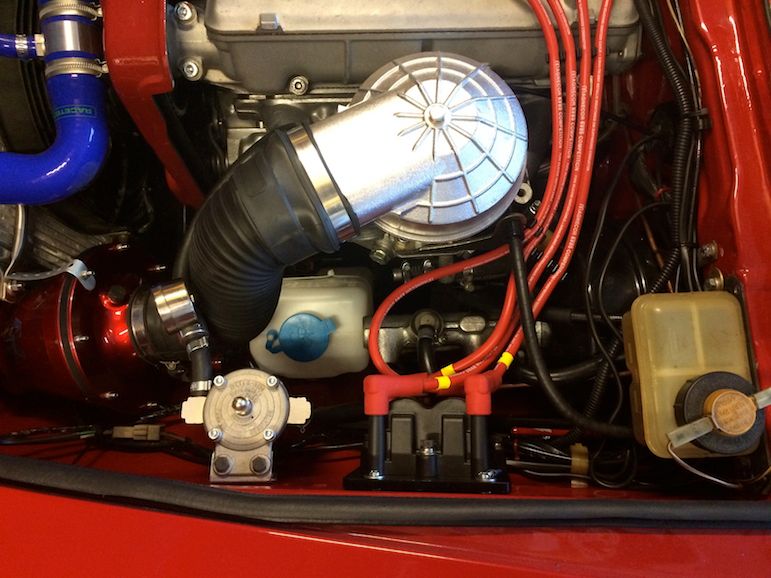
It's getting pretty crowded under there!
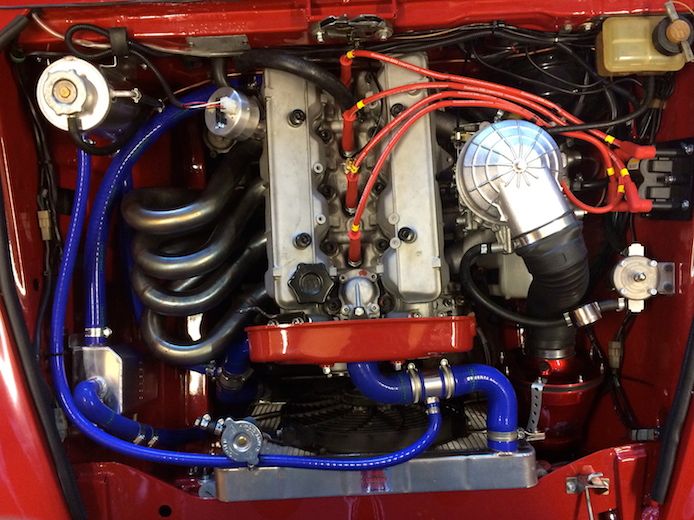
Unfortunately the tune-up did not cure the pinking at high revs under load. So Guy and I assumed this had to be caused by the high under bonnet temperatures. I am sure these are higher than normal because of the much longer primary pipes from the exhaust manifold, coupled with the small K&N filter sitting in the warmest part of the engine bay.
So as you can see I fitted a plenum adaptor from Webcon and a K&N Apollo ambient air intake system that has cured the pinking and is very neat to boot!



I have been having problems with the uprated distributor as the metal trigger ring on the rotor kept slipping, probably due to differential heating, so I fitted a Computronix system from Allison's with a dual coil pack. It is a very powerful system and is a neat installation as you can see:

Here you can see the distinctive trigger unit/distributor:

After the engine was installed I kept getting heating issues as the radiator sits lower than the engine so it was difficult to get rid of air pockets so I fitted a new header tank and you can also see the crank case breather tank on the left.

This left no space for the screen wash bottle so the only place I could find was under the carb area! I'll see how that goes!

It's getting pretty crowded under there!

GC-05
'If you think experts are expensive, you should try amateurs!'
A redline run my GC's engine: https://www.youtube.com/watch?v=80nEhsJbH2w
'If you think experts are expensive, you should try amateurs!'
A redline run my GC's engine: https://www.youtube.com/watch?v=80nEhsJbH2w
-
Will01
- Posts: 590
- Joined: November 26th, 2012, 3:50 pm
- Location: Dumfries, Scotland
- Contact:
Re: 1977 124 Spider CS1 - Lincolnshire UK
I have been following this with interest, i have to say that is one nicely organised and neat engine bay. Looking good and also sounds like you can now enjoy pushing the engine without worrying about det.
Have fun
Have fun
GC_21
-
Nobby
- Posts: 87
- Joined: August 24th, 2010, 11:58 am
- Contact:
Re: 1977 124 Spider CS1 - Lincolnshire UK
Looking lovely - well done!. Is the oil breather hose a little close to the manifold though? Perhaps some p-clips to hold it out of the way or some sort of heatshield?
Chris Burgess
GC 01
GC 01
-
Guy Croft
- Site Admin
- Posts: 5039
- Joined: June 18th, 2006, 9:31 am
- Location: Bedford, UK
- Contact:
Re: 1977 124 Spider CS1 - Lincolnshire UK
Right on the money there Chris.
Phil is a great client and easy to work with. Mercifully the core engine has survived everything thrown at it.
But seriously we are x-ploring the limits of the 124 Spider engine bay here...
Great write-up and photos Sqn Ldr Gilling btw...!
GC
Phil is a great client and easy to work with. Mercifully the core engine has survived everything thrown at it.
But seriously we are x-ploring the limits of the 124 Spider engine bay here...
Great write-up and photos Sqn Ldr Gilling btw...!
GC
Guy Croft, owner
-
PumaPhil
- Posts: 71
- Joined: April 22nd, 2013, 5:18 pm
- Location: Lincolnshire, UK
- Contact:
Re: 1977 124 Spider CS1 - Lincolnshire UK
Yes you're absolutely right Chris, but it is actually below the manifold and clear by a couple of inches, but still too close and hot for my liking.Nobby wrote:Looking lovely - well done!. Is the oil breather hose a little close to the manifold though? Perhaps some p-clips to hold it out of the way or some sort of heatshield?
Getting the under bonnet (hood) temperature down is the next challenge for Guy and I. The irony is that if it was being raced I'm sure it wouldn't be such an issue because of the constant high air flow, but I'm using it for normal driving so in traffic it's getting pretty warm.
Thank you for the kind comments but much of the credit must go to Guy for his excellent help and advice - not to mention patience!
GC-05
'If you think experts are expensive, you should try amateurs!'
A redline run my GC's engine: https://www.youtube.com/watch?v=80nEhsJbH2w
'If you think experts are expensive, you should try amateurs!'
A redline run my GC's engine: https://www.youtube.com/watch?v=80nEhsJbH2w
-
miro-1980
- Posts: 687
- Joined: December 3rd, 2007, 3:40 pm
- Location: Warsaw suburb , Poland
- Contact:
Re: 1977 124 Spider CS1 - Lincolnshire UK
Phil
Excellent project!
My congratulations on the approach you have taken. Truly rare drive to to it right!
No wonder the result is so stunning.
I had to look up your profile to understand where it came from . Having done so I have no doubts.
As they say in Polish Air Force: anything done 99% is not done at all.
As regards under the bonnet temperature, we have been working on it for some time with Guy and now both 131abarth and my 1980 124 CS0 Spider EFI ( soon to become a 1973 Fiat Abarth 124 rally replica) and after some thinking and some trial and error tests got the engine temp under full control.
What worked for the 131 was:
1/ Thorough rinsing of the radiator,
2/ an in-head thermostat (GC selected),
3/ oil cooler (GC selected),
4/ override switch which allows you to turn the fan on manually
5/ lower temperature fan switch
6/ twin Fiat fan (two fans side by side)
What worked for my 124 Spider was essentially the same. I gave a single fan but I have removed the weather-strip sealing the bonnet to the scattle and wings .
The first thing I have found about what needs to be modified in a 124 Spider was a necessity to install the manual override fan switch. I have also a red light which goes on whenever the fan is running (switched manually or by the radiator fan switch) Strongly recommend this as a first step !!!
The 131 and 124 Spider both keep operating temperature practically at constant 85 degrees . No matter if this is a hard driven rally stage or a summer city traffic jam.
What I have found is that while the car is driven, even pushing it real hard the temperature is less of a problem than while driving it through a town traffic during the summer.
My experience ( and extensive discussions with members of this forum and most important GC himself) lead me to believe that the problem is two fold:
1 / insufficient inflow of cold air at low speeds , and
2/ insufficient outflow of hot air especially as low speed.
Accumulation of heat trapped under the bonnet leads to a significant heat inertia. Once everything under the bonnet gets very hot it takes a lot time and lots of fresh a fresh air flow (due to car speed or powerful radiator fan ) to cool it down to proper operating temperature.
The air flow under the hood of both 124 and 131 while driving slowly is by far too low, especially when the engine build to generate significantly more power.
You gave additional problem by installing this very fine exhaust manifold taking a lot of space and obstructing flow fresh air.
So the solution to me consists of several elements increasing good air flow under the bonnet: more cool air in and more hot air out as well as generally getting the engine temp to optimal 85 degrees centigrade.
More cold air in:
1/ While driving - fresh “air drivers” under the front
Fiat used such air drivers (specially shaped metal sheets that would catch fresh air from under the car ad guide it to he engine bay) with great effects. However, this is only good while driving and its effects are largely limited ability of the hot air to escape from under the hood.
2/ a very efficient SPAL fan with manual override switch
More hot air out:
This is the toughest, as it must take into account different air pressure under and over the bonnet ( it is almost as complex as designing a wing by properly shaping the wing attack angle and low / high pressure areas to assure it generates proper lift).
However, your problem seems to be at low speed when the under the bonnet and over the bonnet pressure is low.
In this case two suggestions:
First remove all the rubber weather strips sealing the engine bay to allow the air escaping from under the bonnet more easily.
Second put in a very efficient pushing high air volume due to modern fan design SPAL fan connected to a manual override switch. Connect it through a high amperage relay and use thick low resistance wire copper wire so it could work for extended periods while in traffic.
Unless you have a temp problem while driving at high speed do not change the thermostat or radiator fan switch. However if you decide the car continues to run hot while driving in hot summer city traffic consider a lower temp rated fan switch before making any changes to the thermostat rating. Before making any rating change of the two make sure you get GC to OK. Guy build the engine and knows its optimal operating temp. Remember also that getting the temp too low maybe as bad if not worse than getting is a bit hot. Also make sure you use a reliable temperature gauge , and do not relay on the gauges and sensors installed in the car. These are notorious for significantly low accuracy.
Incidentally I would strongly recommend a very good oil resistant to high temperature degradation and keeping good viscosity at high temp. ( I use Motul 300V Competition, ester based full synthetic - depending on season: either 5W50 from late spring, through early summer and between September through end of October . When I rally in very hot conditions (30++ centigrade) I use 10 W 60. I do not drive the car in the cold season.
You could also go for an adjustable temp fan switch, which allows you to turn the fan automatically at a temp you select by turning a knob. Please remember however that what causes the engine is both the airflow thorough the radiator as wells the flow rate of coolant in the engine ( the higher the speed the greater the coolant flow as the water pump is driven by a V-belt run off the main shaft pulley).
I would also install a oil temp gauge as the best indicator of things going wrong. I have given up the electric clock replaced by oil pressure gauge with a law pressure warning light and installed additionally an oil temp gauge. If you observe these two gauges plus the tacho you are safe as these will give you ample warning before things get real bad.
Hope this is of some use in getting your engine temp within the expected range also in the summer city stop-and-go traffic jam.
Again - a really great project and a stunning result !
Miro
Excellent project!
My congratulations on the approach you have taken. Truly rare drive to to it right!
No wonder the result is so stunning.
I had to look up your profile to understand where it came from . Having done so I have no doubts.
As they say in Polish Air Force: anything done 99% is not done at all.
As regards under the bonnet temperature, we have been working on it for some time with Guy and now both 131abarth and my 1980 124 CS0 Spider EFI ( soon to become a 1973 Fiat Abarth 124 rally replica) and after some thinking and some trial and error tests got the engine temp under full control.
What worked for the 131 was:
1/ Thorough rinsing of the radiator,
2/ an in-head thermostat (GC selected),
3/ oil cooler (GC selected),
4/ override switch which allows you to turn the fan on manually
5/ lower temperature fan switch
6/ twin Fiat fan (two fans side by side)
What worked for my 124 Spider was essentially the same. I gave a single fan but I have removed the weather-strip sealing the bonnet to the scattle and wings .
The first thing I have found about what needs to be modified in a 124 Spider was a necessity to install the manual override fan switch. I have also a red light which goes on whenever the fan is running (switched manually or by the radiator fan switch) Strongly recommend this as a first step !!!
The 131 and 124 Spider both keep operating temperature practically at constant 85 degrees . No matter if this is a hard driven rally stage or a summer city traffic jam.
What I have found is that while the car is driven, even pushing it real hard the temperature is less of a problem than while driving it through a town traffic during the summer.
My experience ( and extensive discussions with members of this forum and most important GC himself) lead me to believe that the problem is two fold:
1 / insufficient inflow of cold air at low speeds , and
2/ insufficient outflow of hot air especially as low speed.
Accumulation of heat trapped under the bonnet leads to a significant heat inertia. Once everything under the bonnet gets very hot it takes a lot time and lots of fresh a fresh air flow (due to car speed or powerful radiator fan ) to cool it down to proper operating temperature.
The air flow under the hood of both 124 and 131 while driving slowly is by far too low, especially when the engine build to generate significantly more power.
You gave additional problem by installing this very fine exhaust manifold taking a lot of space and obstructing flow fresh air.
So the solution to me consists of several elements increasing good air flow under the bonnet: more cool air in and more hot air out as well as generally getting the engine temp to optimal 85 degrees centigrade.
More cold air in:
1/ While driving - fresh “air drivers” under the front
Fiat used such air drivers (specially shaped metal sheets that would catch fresh air from under the car ad guide it to he engine bay) with great effects. However, this is only good while driving and its effects are largely limited ability of the hot air to escape from under the hood.
2/ a very efficient SPAL fan with manual override switch
More hot air out:
This is the toughest, as it must take into account different air pressure under and over the bonnet ( it is almost as complex as designing a wing by properly shaping the wing attack angle and low / high pressure areas to assure it generates proper lift).
However, your problem seems to be at low speed when the under the bonnet and over the bonnet pressure is low.
In this case two suggestions:
First remove all the rubber weather strips sealing the engine bay to allow the air escaping from under the bonnet more easily.
Second put in a very efficient pushing high air volume due to modern fan design SPAL fan connected to a manual override switch. Connect it through a high amperage relay and use thick low resistance wire copper wire so it could work for extended periods while in traffic.
Unless you have a temp problem while driving at high speed do not change the thermostat or radiator fan switch. However if you decide the car continues to run hot while driving in hot summer city traffic consider a lower temp rated fan switch before making any changes to the thermostat rating. Before making any rating change of the two make sure you get GC to OK. Guy build the engine and knows its optimal operating temp. Remember also that getting the temp too low maybe as bad if not worse than getting is a bit hot. Also make sure you use a reliable temperature gauge , and do not relay on the gauges and sensors installed in the car. These are notorious for significantly low accuracy.
Incidentally I would strongly recommend a very good oil resistant to high temperature degradation and keeping good viscosity at high temp. ( I use Motul 300V Competition, ester based full synthetic - depending on season: either 5W50 from late spring, through early summer and between September through end of October . When I rally in very hot conditions (30++ centigrade) I use 10 W 60. I do not drive the car in the cold season.
You could also go for an adjustable temp fan switch, which allows you to turn the fan automatically at a temp you select by turning a knob. Please remember however that what causes the engine is both the airflow thorough the radiator as wells the flow rate of coolant in the engine ( the higher the speed the greater the coolant flow as the water pump is driven by a V-belt run off the main shaft pulley).
I would also install a oil temp gauge as the best indicator of things going wrong. I have given up the electric clock replaced by oil pressure gauge with a law pressure warning light and installed additionally an oil temp gauge. If you observe these two gauges plus the tacho you are safe as these will give you ample warning before things get real bad.
Hope this is of some use in getting your engine temp within the expected range also in the summer city stop-and-go traffic jam.
Again - a really great project and a stunning result !
Miro
www.Fiat-abarth-rally.com
GC_93
GC_93
-
PumaPhil
- Posts: 71
- Joined: April 22nd, 2013, 5:18 pm
- Location: Lincolnshire, UK
- Contact:
Re: 1977 124 Spider CS1 - Lincolnshire UK
Hello Miro,
Many thanks for your comprehensive and informative response. Apologies for not replying earlier but I'd forgotten to set a response notification!
It appears that we have both used the same, or very similar, solutions to tackle the problem (my answers in italics):
1/ Thorough rinsing of the radiator, (new allow radiator with around 30% better cooling)
2/ an in-head thermostat (GC selected), (yes)
3/ oil cooler (GC selected), (yes)
4/ override switch which allows you to turn the fan on manually (yes but temporary fit until I make a neat in-dash solution - with 'ON' light!)
5/ lower temperature fan switch (I am going to buy a thermostat from Revotec - see below)
6/ twin Fiat fan (two fans side by side) (no, but current fan is the largest one that can fit)
I think I may remove the rubber sealing strips around the engine bay, or at least fit shorter sections around the exhaust side so I still get some cushioning for the bonnet.
I also managed to find an original splashguard from the States which fits neatly under the engine and extends back to the cross-member. The air coming through the radiator should now be channelled around the engine and not straight down in front of it, thereby hopefully reducing the hot air at the top of the engine bay.
I do like your idea of fitting an oil temperature gauge in lieu of the clock, I'll give that some thought. I have a separate thread about getting quality gauges here:
viewtopic.php?f=4&t=3267
It is so reassuring to get accurate information from good gauges. The thread shows that I had to install a small LED warning light in the dash as the new oil pressure gauge didn't have one, but I like the LED in the dash, it's discreet yet much brighter than the original gauge's. I may install one next to the water temperature gauge too utilising the old water temperature warning sender.
The solution I may use for the thermostat is from Revotec as I mentioned above (posted with permission of GC):
http://www.revotec.com/acatalog/Electro ... llers.html
http://www.revotec.com/acatalog/EFC_Sel ... tings.html
http://www.revotec.com/acatalog/Threaded_Fitting.html
The guys I spoke to were very helpful and knowledgeable, and offered some sensible solutions to my installation issues, which is why I want to recommend them. For my car I'm considering a self-sealing fitting on the top hose near to the radiator.
One more thing I have done is install a heat shield next to the exhaust manifold. This is because the surrounding silicone pipes, electrical wiring and even the bulkhead were getting very warm! Simply using a few Jubilee clips around the existing pipes is working far better than I could have hoped as holds its form, stays firmly in place and of course everything is much cooler.
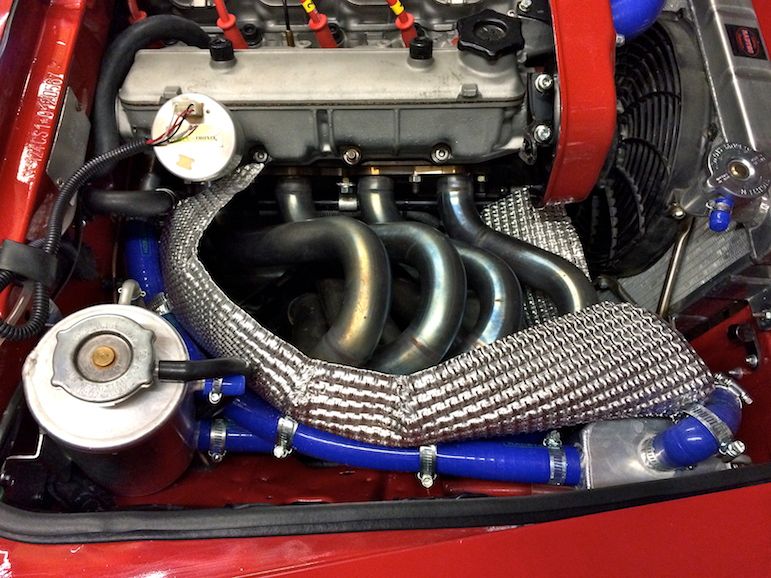
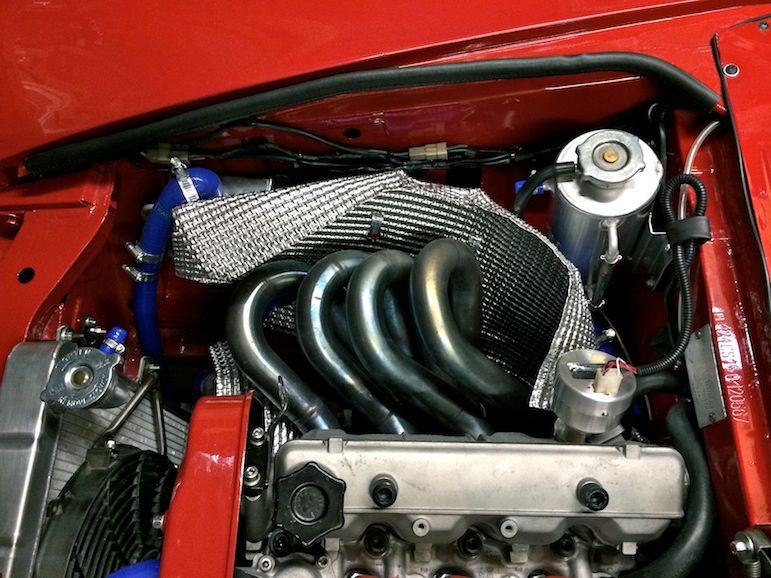
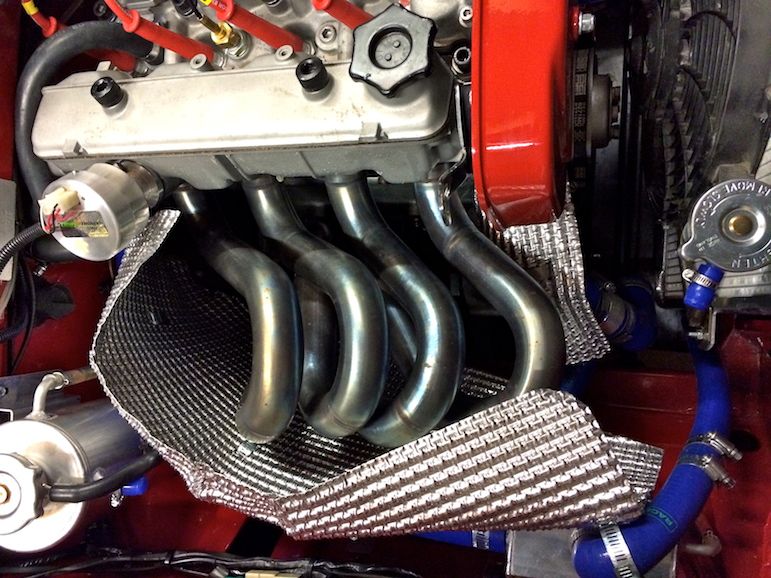
The measures I have taken above (including GC and I finding an air pocket in a heating hose!) have resulted in the water temperature staying at around 77-80 Deg C on a run and 84-88 Deg C in town driving. So I am far happier now!
Thanks again Miro for all your helpful and interesting comments.
Phil
Many thanks for your comprehensive and informative response. Apologies for not replying earlier but I'd forgotten to set a response notification!
It appears that we have both used the same, or very similar, solutions to tackle the problem (my answers in italics):
1/ Thorough rinsing of the radiator, (new allow radiator with around 30% better cooling)
2/ an in-head thermostat (GC selected), (yes)
3/ oil cooler (GC selected), (yes)
4/ override switch which allows you to turn the fan on manually (yes but temporary fit until I make a neat in-dash solution - with 'ON' light!)
5/ lower temperature fan switch (I am going to buy a thermostat from Revotec - see below)
6/ twin Fiat fan (two fans side by side) (no, but current fan is the largest one that can fit)
I think I may remove the rubber sealing strips around the engine bay, or at least fit shorter sections around the exhaust side so I still get some cushioning for the bonnet.
I also managed to find an original splashguard from the States which fits neatly under the engine and extends back to the cross-member. The air coming through the radiator should now be channelled around the engine and not straight down in front of it, thereby hopefully reducing the hot air at the top of the engine bay.
I do like your idea of fitting an oil temperature gauge in lieu of the clock, I'll give that some thought. I have a separate thread about getting quality gauges here:
viewtopic.php?f=4&t=3267
It is so reassuring to get accurate information from good gauges. The thread shows that I had to install a small LED warning light in the dash as the new oil pressure gauge didn't have one, but I like the LED in the dash, it's discreet yet much brighter than the original gauge's. I may install one next to the water temperature gauge too utilising the old water temperature warning sender.
The solution I may use for the thermostat is from Revotec as I mentioned above (posted with permission of GC):
http://www.revotec.com/acatalog/Electro ... llers.html
http://www.revotec.com/acatalog/EFC_Sel ... tings.html
http://www.revotec.com/acatalog/Threaded_Fitting.html
The guys I spoke to were very helpful and knowledgeable, and offered some sensible solutions to my installation issues, which is why I want to recommend them. For my car I'm considering a self-sealing fitting on the top hose near to the radiator.
One more thing I have done is install a heat shield next to the exhaust manifold. This is because the surrounding silicone pipes, electrical wiring and even the bulkhead were getting very warm! Simply using a few Jubilee clips around the existing pipes is working far better than I could have hoped as holds its form, stays firmly in place and of course everything is much cooler.



The measures I have taken above (including GC and I finding an air pocket in a heating hose!) have resulted in the water temperature staying at around 77-80 Deg C on a run and 84-88 Deg C in town driving. So I am far happier now!
Thanks again Miro for all your helpful and interesting comments.
Phil
GC-05
'If you think experts are expensive, you should try amateurs!'
A redline run my GC's engine: https://www.youtube.com/watch?v=80nEhsJbH2w
'If you think experts are expensive, you should try amateurs!'
A redline run my GC's engine: https://www.youtube.com/watch?v=80nEhsJbH2w
-
Guy Croft
- Site Admin
- Posts: 5039
- Joined: June 18th, 2006, 9:31 am
- Location: Bedford, UK
- Contact:
Re: 1977 124 Spider CS1 - Lincolnshire UK
"I may install one next to the water temperature gauge too utilising the old water temperature warning sender..."
Excuse me?!
GC
Excuse me?!
GC
Guy Croft, owner
-
PumaPhil
- Posts: 71
- Joined: April 22nd, 2013, 5:18 pm
- Location: Lincolnshire, UK
- Contact:
Re: 1977 124 Spider CS1 - Lincolnshire UK
Watch the blood pressure Mr C! I was talking about using the old high water temp switch sender in the head (to send the water gauge to full scale) to activate another LED to warn of high water temperature!Guy Croft wrote:"I may install one next to the water temperature gauge too utilising the old water temperature warning sender..."
Excuse me?!
GC
GC-05
'If you think experts are expensive, you should try amateurs!'
A redline run my GC's engine: https://www.youtube.com/watch?v=80nEhsJbH2w
'If you think experts are expensive, you should try amateurs!'
A redline run my GC's engine: https://www.youtube.com/watch?v=80nEhsJbH2w
-
miro-1980
- Posts: 687
- Joined: December 3rd, 2007, 3:40 pm
- Location: Warsaw suburb , Poland
- Contact:
Re: 1977 124 Spider CS1 - Lincolnshire UK
Phil,
Thanks for an extensive response and for the pictures. Looks great.
Wen you look at my engine bay it is apparent that the length of my exhaust collector ( manifold) is much shorter.
This seems to be making the problem worse. Every inch of this pipe emits the heat and the addend length serves as a radiator.
So you are delivering more heat to under the bonnet.
Insulating the area around the manifold seems like a good idea ( i use the same material), but the key is getting the hot air out.
I will bet that lower temp that would kick in at just above 80- deg and switch off at 75 with a manula override switch will do the trick.
However with the lengthy exhaust manifold you will always have a temp rising at low speed and fan switch will get to kick in quite often and stay on longer than if you had a manifold with shorter pipes under the bonnet.
Incidentally, why have you decided you need this manifold ... |is this a 4-2-1 ?
Performance manifold will always give you a heat hassle in town driving (while not racing the car).
Sorry for a stupid question but If you do not race it , why you need a performance manifold ?
If you tried to "race" it on a track , rally or on the open road and the temp stayed under 85 (around 80) than my point seems valid ?
Mine (standard 2.0 fi) keeps the trmp fown as long as I keep it running at 50 + km/h as this generates lofts of fresh air flow.
Whenever I stop at a traffic light in the summer , the temp goes up and the fan stays on after some time I have begun moving at min 50 km/h.
So : a low temp fan switch,manual override and keep it moving (out of the city) where the fun is .
Rgds
Miro
Thanks for an extensive response and for the pictures. Looks great.
Wen you look at my engine bay it is apparent that the length of my exhaust collector ( manifold) is much shorter.
This seems to be making the problem worse. Every inch of this pipe emits the heat and the addend length serves as a radiator.
So you are delivering more heat to under the bonnet.
Insulating the area around the manifold seems like a good idea ( i use the same material), but the key is getting the hot air out.
I will bet that lower temp that would kick in at just above 80- deg and switch off at 75 with a manula override switch will do the trick.
However with the lengthy exhaust manifold you will always have a temp rising at low speed and fan switch will get to kick in quite often and stay on longer than if you had a manifold with shorter pipes under the bonnet.
Incidentally, why have you decided you need this manifold ... |is this a 4-2-1 ?
Performance manifold will always give you a heat hassle in town driving (while not racing the car).
Sorry for a stupid question but If you do not race it , why you need a performance manifold ?
If you tried to "race" it on a track , rally or on the open road and the temp stayed under 85 (around 80) than my point seems valid ?
Mine (standard 2.0 fi) keeps the trmp fown as long as I keep it running at 50 + km/h as this generates lofts of fresh air flow.
Whenever I stop at a traffic light in the summer , the temp goes up and the fan stays on after some time I have begun moving at min 50 km/h.
So : a low temp fan switch,manual override and keep it moving (out of the city) where the fun is .
Rgds
Miro
www.Fiat-abarth-rally.com
GC_93
GC_93
-
PumaPhil
- Posts: 71
- Joined: April 22nd, 2013, 5:18 pm
- Location: Lincolnshire, UK
- Contact:
Re: 1977 124 Spider CS1 - Lincolnshire UK
Hi Miro,
Yes the measures I've taken, as you've done too, do keep the temperature under control and I do need to start the fan in traffic. The manifold certainly increases the surface area enormously and isn't something I'd considered, which leads me on to why I had a race exhaust manifold built.... To be honest I wanted a bespoke system to optimise the work done on the engine, and the guy who made it did it to his normal standards which was for racing cars hence the heat issue wasn't really considered for road use. But in the end the exhaust is fantastic, very efficient and fits beautifully with 2 straight through silencers. I went for 4-1 because it would have been difficult, and much more costly, to make a 4-2-1 system fit with the larger diameter pipes used. He also advised that for fast-road use the longer primary pipes would mean that there would be very little difference between this and a 4-2-1 system.
Here are some pictures of the exhaust that was made in situ in 5 days.
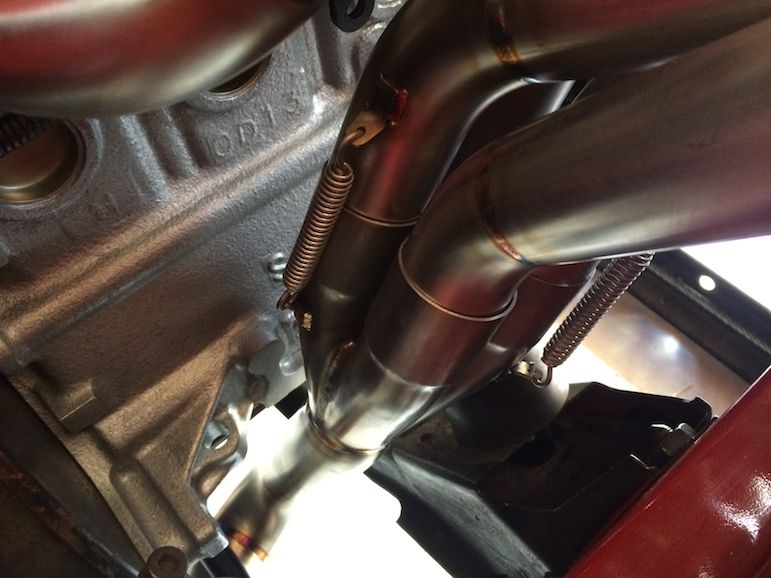
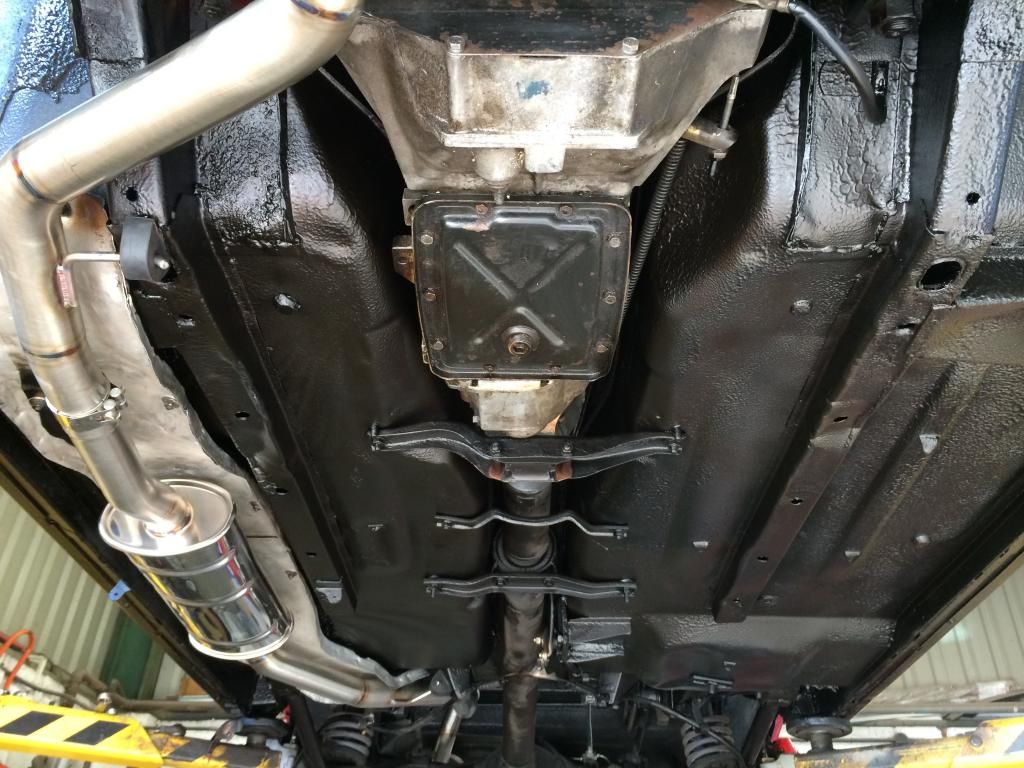
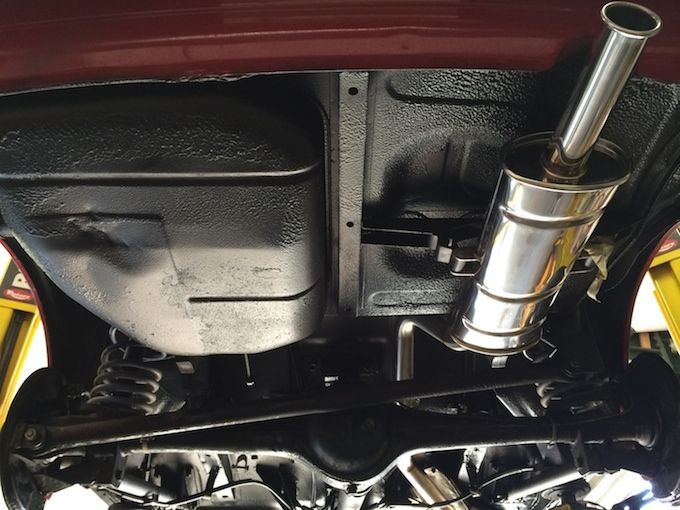
Yes the measures I've taken, as you've done too, do keep the temperature under control and I do need to start the fan in traffic. The manifold certainly increases the surface area enormously and isn't something I'd considered, which leads me on to why I had a race exhaust manifold built.... To be honest I wanted a bespoke system to optimise the work done on the engine, and the guy who made it did it to his normal standards which was for racing cars hence the heat issue wasn't really considered for road use. But in the end the exhaust is fantastic, very efficient and fits beautifully with 2 straight through silencers. I went for 4-1 because it would have been difficult, and much more costly, to make a 4-2-1 system fit with the larger diameter pipes used. He also advised that for fast-road use the longer primary pipes would mean that there would be very little difference between this and a 4-2-1 system.
Here are some pictures of the exhaust that was made in situ in 5 days.



GC-05
'If you think experts are expensive, you should try amateurs!'
A redline run my GC's engine: https://www.youtube.com/watch?v=80nEhsJbH2w
'If you think experts are expensive, you should try amateurs!'
A redline run my GC's engine: https://www.youtube.com/watch?v=80nEhsJbH2w
-
Will01
- Posts: 590
- Joined: November 26th, 2012, 3:50 pm
- Location: Dumfries, Scotland
- Contact:
Re: 1977 124 Spider CS1 - Lincolnshire UK
The quality of workmanship on that exhaust is superb. It looks great.
The collector although we don't have a great view looks well engineered. Unfortunately there are many people out there who seem to make a complete mess when doing this sort of work.
Just great to see a proper job.
The collector although we don't have a great view looks well engineered. Unfortunately there are many people out there who seem to make a complete mess when doing this sort of work.
Just great to see a proper job.
GC_21
Who is online
Users browsing this forum: No registered users and 111 guests